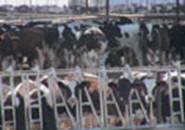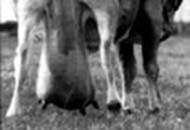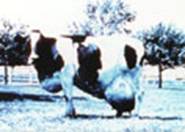
While the number of Canadian dairy farms has decreased by 85% from 1970 to 2003, the volume of milk per farm has increased by 550% in that same period. Dairy cows have paid the price for our greed (1). Dairy cows endure an annual cycle of artificial insemination, mechanized milking, and giving birth. In order for dairy cows (or any other mammal) to produce milk they have to be kept pregnant, otherwise, they would stop lactating when the baby weans (just like humans). Dairy cows are slaughtered around 7years of age when they are “dried up”. The natural lifespan of a cow is about 20+ years. Intensive milking can result in painful and swollen udders. Mastitis is also common in dairy cows—a painful bacterial infection. Humans are the only species to drink the milk of another. Humans do not need cows milk to drink (see our section on vegan health)!
|
|||
 |
 |
 |
|
The even darker side of the dairy industry—calves are taken from their mothers only a couple of days after birth to prevent them from consuming the milk intended for human use. The mal calves live in small crates until they are 4 months old and slaughtered for veal (1). This is industry standard in Canada and yet another example of unnecessary pain and suffering. Transport: Crammed together, animals must stand in their own excrement while exposed to extreme weather. According to regulations under the Health of Animal Act, cattle (beef, dairy and veal) may be transported without food, water, or rest for up to 52 hours (1). Whether beef, dairy or veal they all suffer the same fate. There were close to 25,000 calves and cattle slaughtered for human consumption in 2005 in Nova Scotia alone (2).
References: (1) www.humanefood.ca. (2) www.gov.ns.cs.nsaf |
|||
|
|||